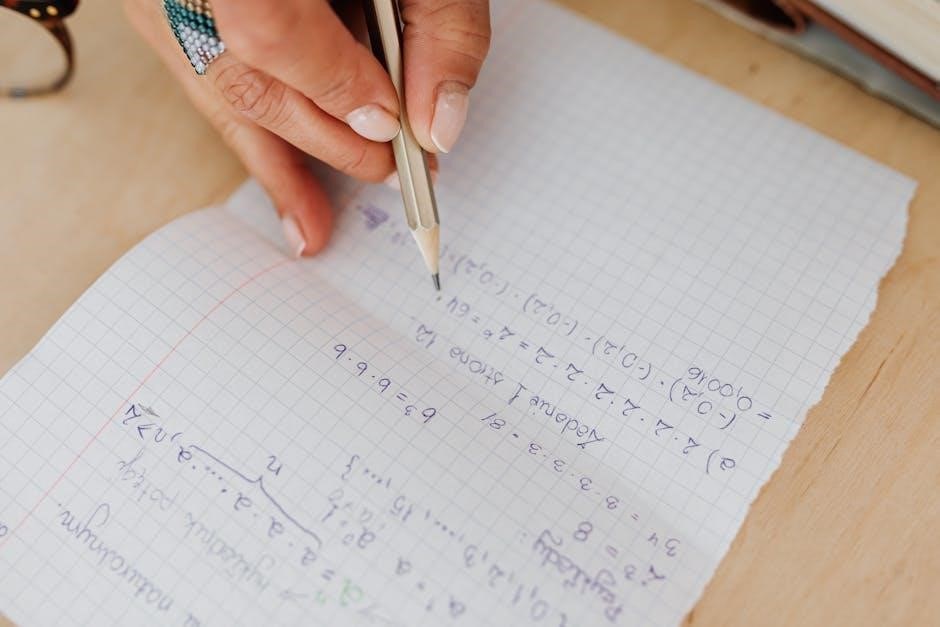solving radical equations worksheet with answers pdf
Radical equations involve variables under square roots, cube roots, or higher-order roots. Solving them requires isolating the radical and raising both sides to the root’s index, ensuring to check for extraneous solutions to maintain validity. These equations are fundamental in algebra and real-world applications like physics and engineering.
What Are Radical Equations?
Radical equations are algebraic equations that contain variables under a radical sign, such as square roots, cube roots, or higher-order roots. These equations often require specific techniques for solving, as the variable is embedded within a root. To solve them, isolating the radical is typically the first step, followed by raising both sides of the equation to the power of the root’s index to eliminate the radical. This process can sometimes introduce extraneous solutions, which must be checked by substituting them back into the original equation. Radical equations are fundamental in algebra and have practical applications in fields like physics and engineering.
Importance of Solving Radical Equations
Solving radical equations is essential for mastering algebra and preparing for advanced mathematics. These equations frequently appear in real-world applications, such as physics, engineering, and geometry. For instance, they are used to calculate velocities in free-falling objects and distances in geometric problems. Understanding how to solve radical equations enhances problem-solving skills and logical reasoning. Additionally, it lays a foundation for tackling more complex mathematical concepts, such as exponential and logarithmic equations. Practicing with worksheets and identifying extraneous solutions helps build accuracy and confidence. Solving radical equations is not only academically valuable but also practical for everyday problem-solving scenarios.
Understanding Radical Equations
Radical equations contain variables under square roots, cube roots, or higher-order roots. They require specific algebraic techniques to isolate the radical and solve for the variable effectively.
Types of Radical Equations
Radical equations can be categorized based on the root’s index and the equation’s complexity. Common types include square root equations, cube root equations, and higher-order radicals. Additionally, equations may contain single or multiple radicals, and the variable can appear inside or outside the radical. Some equations involve radicals on both sides, requiring careful manipulation to solve. Each type demands specific strategies to isolate the variable, ensuring solutions are valid and not extraneous. Understanding these variations is crucial for effectively solving diverse radical equations encountered in algebra and real-world applications.
Key Properties of Radical Equations
Radical equations possess unique properties that influence their solutions. The index of the radical determines the equation’s behavior; even-indexed radicals yield non-negative results, while odd-indexed radicals can produce negative outcomes. Raising both sides to the nth power eliminates the radical but may introduce extraneous solutions. Domain restrictions, such as avoiding negative inputs for even roots, are critical. Additionally, radicals can simplify equations by representing complex relationships concisely. These properties require careful handling to ensure valid solutions and maintain the equation’s integrity. Understanding these characteristics is essential for effectively solving and interpreting radical equations in various mathematical contexts.

Step-by-Step Guide to Solving Radical Equations
Solving radical equations involves isolating the radical, raising both sides to the root’s index, and simplifying. This structured approach ensures accurate solutions and prevents extraneous results.
Isolating the Radical
Isolating the radical is the first step in solving radical equations. To isolate the radical, ensure all other terms are moved to the opposite side of the equation using addition, subtraction, multiplication, or division. For example, in the equation x + 3 = √(x² + 9), subtract x from both sides to isolate the radical: 3 = √(x² + 9) ⎻ x. This step simplifies the equation, making it easier to eliminate the radical by raising both sides to the appropriate power. Always check for extraneous solutions after isolating the radical and solving the equation.
Raising Both Sides to the nth Power
Raising both sides of the equation to the nth power is a critical step in solving radical equations. After isolating the radical, this method eliminates the root, allowing you to solve for the variable. For example, if the equation is 3 = √(x² + 9), squaring both sides yields 9 = x² + 9, simplifying to x² = 0. When the radical’s index is even, this step can introduce extraneous solutions, so it’s essential to verify all answers in the original equation. Always check for validity to ensure accurate results and avoid incorrect solutions.
Simplifying the Equation
Simplifying the equation is a crucial step after raising both sides to the nth power. It involves algebraic manipulations to isolate the variable and solve for its value. This may include expanding expressions, combining like terms, or performing arithmetic operations. Carefully simplifying ensures the equation is in its most straightforward form, making it easier to identify the solution. Accurate simplification is vital to avoid errors that could lead to incorrect or extraneous solutions. Always double-check your work during this step to ensure the integrity of your final answer. Proper simplification paves the way for verifying solutions in the original equation.
Practice Worksheet: Solving Radical Equations
This worksheet provides a variety of radical equations to practice solving. Each problem helps master the concept of solving radical equations. Answers are available in PDF format.
Sample Problems
Solve for x: √(x + 2) = 5
Solve for y: ∛(y ⎻ 3) = 2
Solve for z: √(z) = 4
Solve for x: √(x) + 2 = 7
Solve for y: √(2y + 5) = 3
Solve for z: ∛(z ⎻ 1) = 3
Solve for x: √(x) = 9
Solve for y: √(y + 4) = 6
Solve for z: √(z ⎻ 7) = 4
Solve for x: √(x + 1) = 8
These problems cover various types of radical equations, including square roots and cube roots. Solutions should be checked to ensure they are valid and not extraneous.
Real-Life Applications
Radical equations are essential in solving real-world problems involving distances, velocities, and geometric measurements. For instance, in physics, the velocity of a free-falling object can be modeled using radical equations. Architects use square roots to calculate distances and dimensions in building designs. Engineers apply radical equations to determine stress and load capacities in materials. Additionally, radical equations are used in medical fields to model drug concentrations and rates of diffusion. These practical applications highlight the importance of mastering radical equations for problem-solving in various professions. They demonstrate how mathematical concepts translate into tangible solutions for everyday challenges.

Checking for Extraneous Solutions
Extraneous solutions arise when raising both sides of an equation to a power introduces invalid results. Always verify solutions by substituting them back into the original equation to ensure they satisfy it, maintaining the integrity of the radical expressions and the equation’s balance.
Why Extraneous Solutions Occur
Extraneous solutions occur when radical equations are manipulated, particularly by raising both sides to a power, which can introduce solutions that do not satisfy the original equation. This happens because squaring or raising to an even root eliminates the sign distinction, potentially creating false roots. Additionally, multiplying both sides by expressions containing variables can introduce solutions that do not hold true in the original equation. These extraneous solutions often arise from the algebraic steps taken to isolate the radical, making it essential to verify all potential solutions by substituting them back into the original equation to ensure their validity.

Verifying Solutions
Verifying solutions is a critical step in solving radical equations. After obtaining potential solutions, substitute them back into the original equation to ensure they satisfy it. This step is necessary because raising both sides of an equation to a power can introduce extraneous solutions. Even if algebraic manipulations appear correct, some solutions may not hold true in the original equation. Additionally, always check that solutions are within the domain of the original equation, as certain values may result in invalid expressions, such as taking the square root of a negative number. Verification ensures the integrity and accuracy of the solutions obtained.

Common Mistakes and Tips
Common mistakes include improper handling of radicals and forgetting to verify solutions. Tips: isolate radicals first, raise both sides to the nth power, and always check solutions in the original equation to avoid extraneous results.
Avoiding Errors in Radical Equations
Common errors in solving radical equations include improper handling of radicals and forgetting to verify solutions. To avoid these, always isolate the radical first and raise both sides to the nth power carefully. Ensure the index matches the root for proper elimination. After solving, substitute solutions back into the original equation to identify extraneous results. Additionally, avoid squaring both sides unnecessarily, as this can introduce false solutions. Pay attention to restrictions on variable domains, such as non-negative values under square roots. By following these steps and double-checking work, learners can minimize errors and master radical equations effectively. Consistent practice also improves accuracy.
Best Practices for Solving
When solving radical equations, follow a systematic approach to ensure accuracy. Always start by isolating the radical term on one side of the equation. Next, raise both sides to the power that matches the radical’s index to eliminate the root. After simplifying, check each solution in the original equation to confirm it is valid and not extraneous. Additionally, consider squaring both sides only when necessary and avoid introducing unnecessary steps that could complicate the equation. By adhering to these practices, learners can efficiently solve radical equations and maintain precision in their solutions. Regular practice also enhances problem-solving skills and speed.
Mastering radical equations requires practice and careful solution verification. Regular worksheet exercises help build proficiency, ensuring correct and valid answers in various mathematical and real-world scenarios.
Radical equations involve variables within roots, requiring isolation and raising both sides to the root’s index to solve. Key steps include isolating the radical, raising both sides to the nth power, and simplifying. Always check solutions for extraneity by substituting back into the original equation. Practice worksheets help reinforce these methods, ensuring accuracy and understanding. Real-life applications highlight their importance in fields like physics and engineering. Mastering these concepts enables effective problem-solving in various mathematical scenarios, emphasizing the need for careful verification to avoid invalid solutions. Regular practice with worksheets is essential for building proficiency and confidence in solving radical equations.
